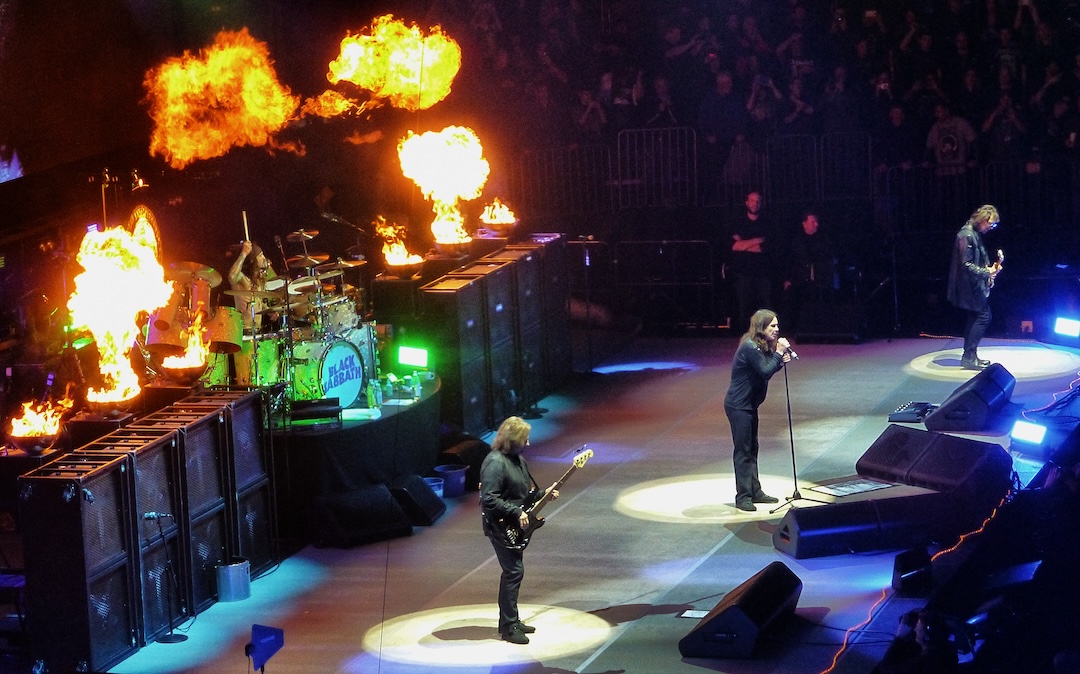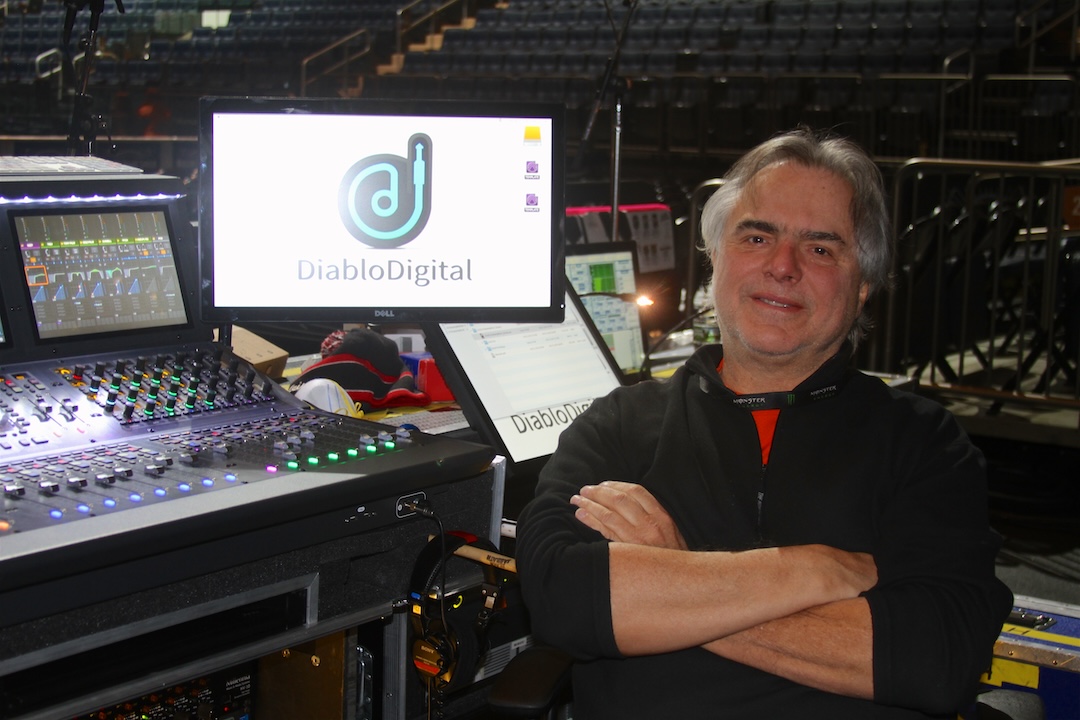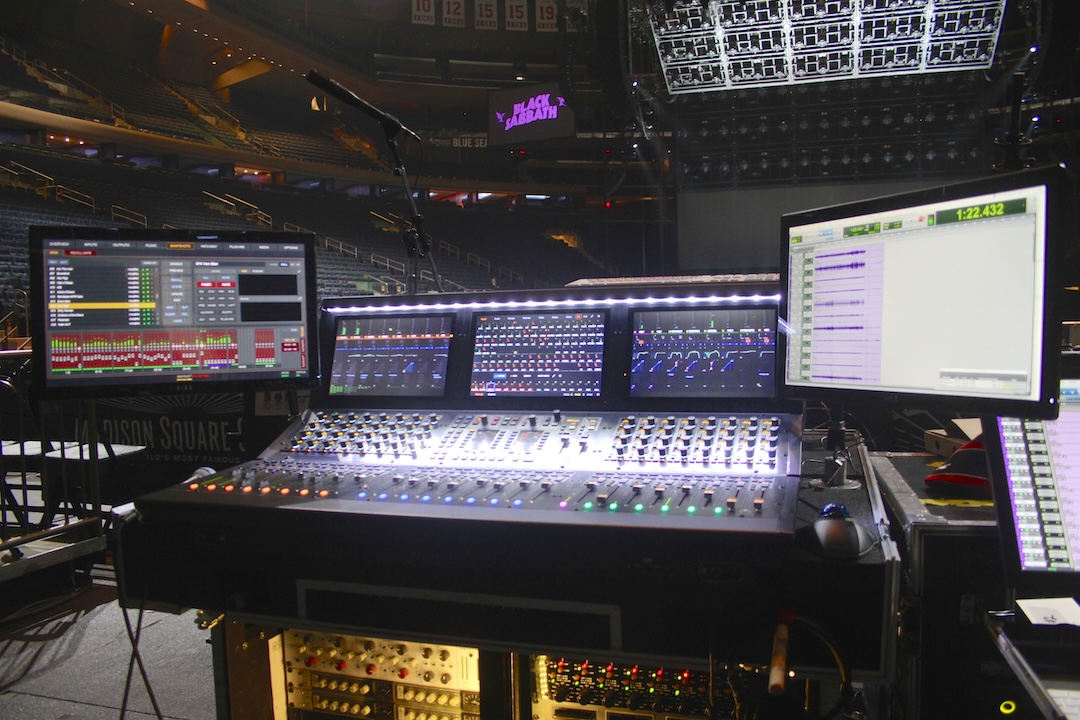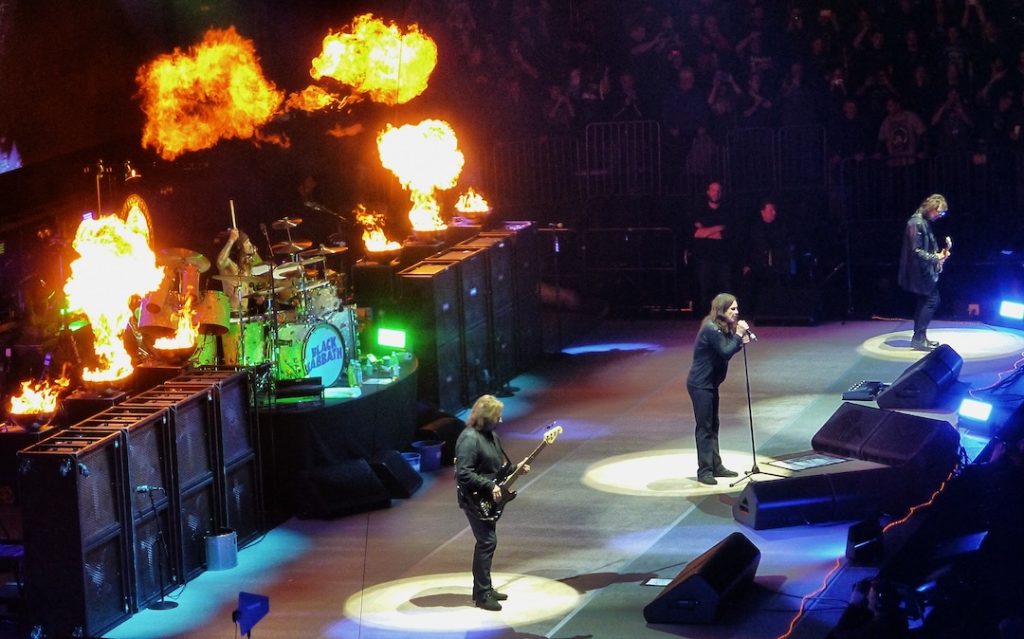
New York, NY (April 16, 2016)—The end is nigh, my brothers and sisters of the sonic cloth—bow your heads and hold up your horns in reverence. The time has come for the architects of heavy metal, Black Sabbath (henceforth referred to as “Sabbath”), to write the final chapter of their storied career. THE END tour, which kicked off in January and features original members Ozzy Osbourne (vocals), Tony Iommi (guitar), and Geezer Butler (bass), as well as touring musicians Tommy Clufetos (drums) and Adam Wakeman (keyboards), will mark the end of the band’s nearly 50-year career.
As he’s done for close to 20 years, Greg Price is the man behind the front of house console, capturing Sabbath’s signature sound. For this historic outing, Price is relying on Clair Global’s new Cohesion loudspeaker system to reproduce the wide range of tones that Sabbath is known for.
“I’m not the first person to use the Cohesion 12,” states Price, “but I think we’re the first heavy metal band to take it out. So far, we really like it a lot. It’s another extension in the evolution of speaker design—it is fantastic.”
Price is so impressed with sounds that the system is allowing him to reproduce that he’s been able to break from the normal miking routines that most engineers follow and truly find the right tool for the job.
“Most guys will put their favorite mic up and then they’ll EQ around it to draw the sound out,” explains Price. “The Cohesion 12 has allowed me to find the right mic—or the right DI box, or whatever apparatus—for the right input. So, I have a potpourri of microphones up there. For instance, we have a Shure SM 58—which is a vocal mic—on the snare top. The snare top mic had broke and a 58 is the classic ‘test the line’ microphone, so I said, ‘Just put it up there and let’s see what it sounds like.’ It was instantly the sound that we were looking for. With the Cohesion 12, we’re hearing the true nature of that microphone on an input that you never would have thought you would have used it on,” he adds. “So that’s been a paradigm shift for me. When I can’t find the sound that I’m looking for, I don’t grab the EQ, I don’t look for a plug in—I go and change the mic. It really adds a whole new dimension for me.”
Price met with the band in November to begin pre-production for the tour, which is when he went to work finding the optimal ways to capture the band’s mammoth tones. One of the techniques that he experimented with, that he picked up from his previous gig with Van Halen, helped add even more depth to Clufetos’s drums.
“Alex Van Halen wanted more of a room sound for his drum kit without me manufacturing it with reverb,” explains Price. “Well, how do you do that? I did some research, and I found that Led Zeppelin did it by putting a single overhead over the top of the drum kit. I tried it, and it really worked. On Tommy’s drum kit, I’m using a single Audio-Technica AT4050 right over the top of the kit, and it’s loud—it’s probably the loudest input on the kit. When I started using this with him in rehearsal, it was a game-changer. There is some delay offset, which is natural, and I did play with it a bit, but I chose to let the natural ambience that was being developed between the two mic positions speak to a specific sound.”
Price uses a related delay offset technique to help capture the differences in Iommi’s guitar tone as well. “I set up mics on-axis and off-axis to Tony’s cabinets, and then I use those different textures for different sections of the songs,” he explains. “If you listen to a Sabbath record, Tony would play a rhythm guitar part that was kind of edgy and nasally, then his lead tones were full-on, and it would cut right through. So, I wanted to capture those variations in tone, and with the Avid Venue S6L console that we’re using at FOH, it’s easy for me to create a series of snapshots to have a verse or a chorus or a guitar bridge where the guitar tone changes and it just mutes one channel and it brings on the other.”

When asked about the Geezer Butler-driven low end, Price is quick to note that the bass is not as low as it seems. “That’s a very fine dance,” he states. “When you listen to vintage Sabbath records, it’s not Drowning Pool—there’s not a lot of low-end on their records. There’s a very articulate bass tone. When we talk about low-end, would you define that as 80 cycles and down? For me, as a recording engineer, low end starts at 100 cycles because, when you make a record, yes, you want all of those artifacts on that record, but, in reality, not many people can hear it. My mix is very thick and wide-frequencied, but not sub-frequency heavy.”
“On the last Sabbath tour, we did a lot of shows with no sub bass on the ground,” he adds. “What I was trying to strive for, and what we talked about to the folks at Clair when they were designing the new PA, was let’s get it full-frequency and full-bodied in the air so that the people on the ground aren’t getting their shorts blown off. It’s just ridiculous sometimes. Yeah, I’m an older guy, but if I went to an Eagles concert and it was just sub and I couldn’t hear Don and Glenn (rest in peace) sing, I’d be pissed. And that happens a lot. So, we really tried to develop that full-bodied bass sound in the air.”
As for Ozzy, Price explains that he’s been using the same mic for the last 20 years to capture his vocals. “Ozzy has really stepped up to the plate on this tour,” he exclaims. “I’m still using a Shure Beta 58A with a wireless stick, and the vocal sound on this PA is absolutely what I’ve been looking for all these years. And I’m not using any plug-ins with him—just a little EQ.”

Price also took a different approach when it came to setting up the Avid Venue S6L that’s on the road with him. His goal in rehearsals was to build what he calls a “static mix,” a technique that he picked up from Jack Joseph Puig, that relies on the basics to capture the fundamentals of the band’s sounds. “The static mix is no simpler than mic pre gain, Hi Pass and Lo Pass filtering, panning, and then you mix straight to the stereo bus; this is a straight left and right mix,” he explains. “Once you develop that, that’s the static mix, then you can start building your mix and going with plug-ins and developing your style, but the true nature of the band is in the mix.
Remember, this is a true drums, bass, guitar, vocal band; this isn’t Beyoncé where there’s a lot of stuff going on. So, what I like to do is develop it and put it away. Label it on the console ‘Static Mix’ so that when I get sideways, I can always go back to it to see what it is that I’ve screwed up. And believe me, we can screw things up. I call it the ‘Creep Factor’—we’re humans, and, by nature, we want to continue to fiddle with stuff and make things better in our mind.”
Discover more great stories—get a free Mix SmartBrief subscription!
“I don’t do this on my own,” interjects Price. “Simon Bauer, who’s my system engineer—we developed this sound together. For future engineers, this is no different than when we’re in the recording studio and you have an engineer and a producer, and the two of them work together to develop that sound. It’s no different than that today here in live sound performance; that dynamic is alive and well.”
With a tour that represents the final act of a legendary band, you can’t help but look back at your own experiences, which prompts Price to add, “I really want to thank the folks at Clair for their support with us, and with me, over the years as well. I wouldn’t be here if it wasn’t for them and their people.”
Iron Man Ozzy Visits Iron Mountain
While the tour is a celebration of the band’s career, as well as its fingerprint on modern heavy music, it’s definitely a bittersweet moment hearing Black Sabbath sound the best that they’ve sounded in years at the hands of Greg Price and his team. There is nothing left to say but THE END….
This article first appeared in the April 2016 issue of Pro Sound News as “The Beginning of the End.”
| VITAL STATS
Black Sabbath Clair Global (Lititz, PA) |
| FOH Engineer: Greg Price
Monitor Engineer: Myles Hale Systems Engineer: Simon Bauer Monitor Systems Engineer: Thomas Morris Tech: Katy Hughes, Kory Lutes FOH Console: Avid S6L 24D Monitor Console: Avid S6L 24D House Speakers: Clair Cohesion C0-12, CP-218, CM-22 Monitor Speakers: Clair Cohesion CM-22, SRM, CO-8 fill Personal Monitors: Shure PSM 1000 House Amplifiers: Clair StakRak (Lab.gruppen) Monitor Amplifiers: Clair StakRak (Lab.gruppen) FOH Equipment/Plug-Ins: Lake LM44; Diablo Digital recording systems with Avid S3L-X control surface Microphones: Shure Beta91a, SM91, SM57, SM58, Beta 98, VP88; Sennheiser 902, 904, e914, 409, ULXD wireless; Neumann KM84; AKG 460, C414; Electro-Voice N/D38; Radial DI; Millennia Media DI; Audio-Technica AT3000, AT4050; sE Electronic SE T2, Voodoo; Royer SF12 |

